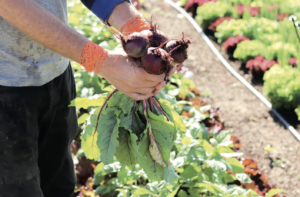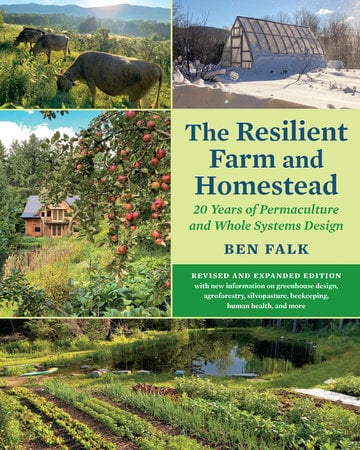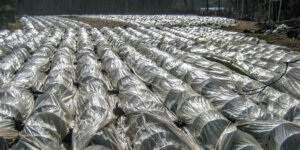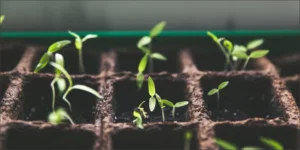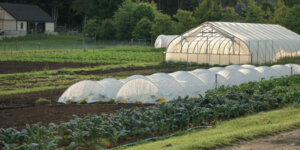Drop the Beet: Growing No-Till Beets
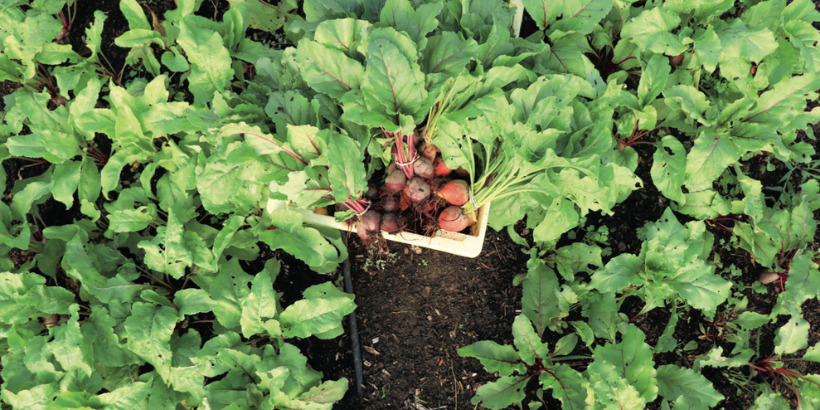
Let’s drop the beet! Beets can be grown year-round and are a perfect, flavorful addition to meals. Get started on growing your own no-till beets with help from these tips!
The following is an excerpt from The Living Soil Handbook by Jesse Frost. It has a been adapted for the web.
How to Grow No-Till Beets
Both a cold- and heat-hardy crop, beets are one my favorite year-round vegetables to grow. Beets also make an excellent intercrop. And when piled on the table, they really draw customers in, and we can sell nearly every bunch of beets we bring.
Getting Started: Estimated Seed Quantities
We transplant most of our beets; we purchase 1,200 seeds per 100-foot (30 m) bed or 300 seeds per single row. We do not direct seed beets often because (like Swiss chard) beet seeds are multigerm seeds that produce multiple plants from one seed, which results in plantings that are too dense.
For times when we do plan to direct seed, we purchase approximately 1,600 seeds per bed.
Bed Prep for No-Till Beets
Beds are fertilized and a small amount of compost mulch is added if needed. We soak the trays of beet seedlings in compost tea or extract before trans- planting. During the bulk of the summer months—late May through late August—we plant all of our beets under 30 percent shade or in the tunnel.
The small amount of shade helps establish the beets but also produces more marketable greens. For direct seeding, beets take 5 to 7 days for germination and prefer soil temperatures around 85°F (30°C). Keep the soil moist until germs appear.
Pest Control
So long as we plant beets under some amount of shade, we do not have issues with Cercospora leaf spot or the other common leaf diseases. Blister beetles occasionally attack our beets.
If we spot blister beetles on other crops (usually the spring chard when it begins to weaken over the summer) we cover the beets with insect netting such as ProtekNet or a lightweight row cover at transplant or upon emergence.
Weed Control
As with other crops, transplanting the beets into a mulched, weed-free bed is our strategy for weed control. However, if direct seeding, the story is a little different. Beds are prepped with ample compost mulch.
To speed up germination we will add either heavyweight row cover or a tarp with the white side down for a few days—you want this process to take the least amount of time possible to discourage competition.
Beets are a 50- to 70-day crop, post emergence, so we cultivate at least once after they have fully emerged, even if we don’t see weeds.
Seed Starting and Seeding
We sow all of our beets into 11⁄8-inch (29 mm) soil blocks made with the Stand-up 35 Soil Blocker. We place only one seed per block. In the spring, we place soil blocks on a heat mat in our greenhouse to speed germination.
In the summer, they can germinate in a well-ventilated greenhouse with no bottom heat required.
Blocks are covered lightly with vermiculite or soil mix to retain water and encourage germination. To make sure that mice do not have access to these blocks, we place them on a table that mice cannot climb up onto (metal legs usually work). Mice will devour beet seeds.
Beet Seed Sizing
Beet seeds vary in size, so when sowing beet seeds directly into beds, we pair the size of the beet seed to the seeder or seed plate. Generally, we use the LJ-24 roller on the Jang with the sprockets set at 14 in the back and 9 in the front to space the seeds about 2.5 inches (6 cm) apart.
The beet plate on the EarthWay seeder is effective as well, though the chances of sowing the crop too thickly are higher with the EarthWay because it lacks the accuracy of the Jang. If direct seeding, we like to start a couple of trays of extra beets to fill in any gaps.
Spacing and Planting
When transplanting, we set four rows about 7.5 inches (19 cm) apart, with the beets transplanted at around 4 inches (10 cm) apart in the row. A rainy day is a good opportunity to thin the blocks in the greenhouse to two seedlings per block.
This is more efficient than trying to do the thinning in the field. For direct seeding we sow five rows of beets, with the seeds spaced two to three inches (5 to 8 cm) apart. We thin direct-seeded beets only if necessary.
Harvesting and Yielding No-Till Beets
We harvest beets after all the tender greens are out but before crops such as carrots are ready. When beets are largely two inches (5 cm) in diameter, we bunch them with rubber bands in the field, peeling off any yellow or rough leaves.
Three large or four medium-sized beets make a marketable bunch.
We also bunch up any remaining small beets in bunches of five or six to sell as “baby beets”—a popular item at our market.
Beets are then gently washed on our washing table, drip-dried, or gently shaken off.
We pack them in totes and store them in the walk-in for market. Harvest never occurs more than 2 days before market.
Our goal is 300 bunches per 100-foot (30 m) bed, which works out to an earnings between $700 and $900 per bed.
Intercrops
Beets are fairly competitive, and they are one of my favorite intercrops. They also do not make mycorrhizal associations, so we find it benefits them to have other crops around that do. My favorite pairing is with solanaceous crops such as peppers, tomatoes, and potatoes.
They also work well in a relay cropping scenario where, for instance, the bigger beets are thinned from a bed in the first harvest. A round of summer squash is then planted into that bed. While the squash establishes, we complete the beet harvest the following week.
Beets, like head lettuce, are a great filler among poorly germinated carrots, as well.
Notable Struggles When Growing No-Till Beets
Our biggest struggles with beets have come from overseeding them, resulting in an overly thick stand that will not produce sizable beets. Thinning beets is extremely time consuming!
On the flip side of that coin, when direct-seeding beets into compost, we have found that poor germination happens.
Finding New Solutions
Our solution has been to choose the seeder based on the size of a particular batch of seeds, as mentioned previously. It also helps to cover the beds and keep the beds extremely moist for germination.
Lastly, mice have contributed to no shortage of beet failures in our greenhouse, and we have learned to germinate the beets on something rodent-proof.
One technique is to put them on a table with metal legs that mice cannot easily climb (card tables work well for this), and place the table away from a wall. A slick plastic tote or barrel can work as well, too, where the beet trays are simply piled on one another until germs appear.
Recommended Reads
Recent Articles
Want to grow year-round, but a greenhouse feels like a big investment? When it comes to cost and flexibility, low tunnels are the all-around winners.
Read MoreWintergreen is the stunning evergreen groundcover that’s a game-changer for your garden! It’s cherished for its aromatic leaves, vibrant fall color & bright berries.
Read MoreGrow winter carrots for a sweeter & more flavorful harvest! Ditch the bland, store-bought carrots this winter! Grow your own winter carrots for a sweeter and more flavorful twist 🥕🥕
Read MoreSearching for the perfect book to give the homesteader in your life? We’ve got your go-to books for anyone interested in organic growing, permaculture, soil health, year-round growing & more! What’s their next great read?
Read MoreWinter is coming… but that doesn’t mean you should put away those tools just yet. Extend the growing season well past the first frost!
Read More

